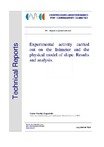This technical report illustrates the main results obtained from the experimental activity performed with both physical model of slope and lisimeter. The set of data is referred to the variation of physical variable as suction and water content in soil sample measured during the tests.
In the tests carried out with the physical model rain induced flowslides are simulated. Here the artificial rain is almost uniform over the sample surface and characterized by a constant intensity. The seepage of rain water develops principally along the slope direction and the sample thickness, increasing water content and, as a consequence decreasing suction until to reach sample failure.
In the case of the experimental activity performed with lisimeter the moisture of soil sample is regulated directly by weather conditions. Nevertheless the water flow can pass trough the sample only vertically as the lateral wall of the tank containing it are water proof. So a real one dimensional seepage process is investigated.
The whole set of data allows to analyze the water store capability of pyroclastic soils starting from different conditions in terms of suction and/or soil water content. Moreover the data obtained with the physical model are also able to indicate how the seepage process determines the saturation of the sample before failure occurs.
A first attempt to interpret the suction measurements has been also discussed. It consists of a numerical analysis carried out using the commercial software Surfer to make interpolation of suction data along a longitudinal sample sections where the tensiometers have been put in place. This allowed to estimate the trend of suction variation inside the sample as well as how it was saturated.
NEW NUMBERING (new series “Research papers”): RP0044
OLD NUMBERING (previous series “Technical reports”): TR27
CMCC Divisions
Authors
- Keywords: lisimeter, physical model of slope, seepage, suction measure


